WHICH IS THE BEST WOOD FOR A SAUNA?
Sitting in a sauna and sweating out your daily troubles and stresses is one of the greatest feelings and pleasures. Adding a sauna to your home is a dream for many homeowners. If you're looking to do the same, there are several factors to consider, but the type of wood sauna is the most important.
Each wood type has specific characteristics that affect the microclimate and experience during your sauna session. To make it easier to know which one is best for you, we've compiled the best types of wood for saunas in this article.

Qualities of the Best Wood for a Sauna
Temperature Resistant
It's essential to use heat-resistant wood when setting up your sauna. For instance, a traditional wood-burning sauna can reach 200 degrees Fahrenheit. So, selecting a wood type that doesn't absorb heat is the key to selecting the ideal sauna wood. This is a crucial detail for the best sauna experience. If the wrong type of wood is used, the high temperatures in a sauna cause it to become hot too the touch, making your luxurious oasis incredibly uncomfortable or dangerous.
Generally, softwoods radiate less heat than hardwoods which explains why they're often chosen in sauna construction. Picking softwoods, such as cedar or white fir for your outdoor or indoor sauna design is advisable.
Water Resistant
Water-resistant surfaces are imperative in keeping your sauna clean. This is especially true if you're using a sauna with hot sauna rocks that you pour water on to generate steam. The ideal wood prevents moisture from spilled drinks or sweat from getting trapped in your sauna's wooden panels. This helps prevent discoloring and molding over time if left unchecked.
Durability
When picking a sauna or constructing your own, you want to ensure it lasts as long as possible. Therefore, choosing a robust wood sauna that doesn’t crumble under the elements is of utmost importance.
Aroma
While some sauna enthusiasts prefer aromatic wood types (such as cedar), others don't. This is all about your personal preference and taste. However, there are others who might be sensitive or allergic to the wood phenols that generate smells. As a result, a preferable option is more neutral woods. It's advisable to know the kind of smell you like before picking the wood for your sauna.
Density
The average density value is 15% moisture for every wood type. In different climatic regions and conditions, and depending on the tree's age, the density value can vary significantly.
Thermal Conductivity
Thermal conductivity is how energy is transferred from the warm to the cold part of the wood. For sauna wood, it shouldn't have a high thermal conductivity implying the smaller, the better. The thermal conductivity values are given under conditions close to those of a sauna.
Resistance of Wood Due to Compression
This is also known as drying out. The value functions are categorized into low splitting resistance, medium, and high for the best wood sauna and ease of use. Naturally, the lower the number, the better the wood.
Antifungal and Antimicrobial
The air humidity and moisture combined with the warm sauna environment may encourage the growth of fungus or microbes. Therefore, selecting a wood type naturally resistant to these is advisable.
Good Insulator
Your wood sauna should help keep the heat inside, or the sauna will be ineffective and expensive to run. It will take too much energy or firewood to reach the required high temperatures.
Cost
Every person has a budget, so the amount you pay for your sauna wood is important to consider. However, going for the cheapest option is not always the best as it may indicate lower quality and cheaper wood materials. You can still save money by using different wood types for different areas. For instance, opting for high-quality wood for your benches and walls because your skin will have contact with them.
Best Wood for a Sauna: Softwoods vs. Hardwoods
Softwoods
Softwood comes from fast-growing conifers making the wood weaker and softer. This implies that most saunas are made of softwoods that are durable and tough enough to last, such as cedar, basswood, eucalyptus, and thermo-spruce. Softwoods are mainly used for kindling as they're softer and easier to light.
Hardwoods
Hardwoods are wood types from deciduous trees and have leaves that can be found in basswood, eucalyptus, or polar, for example. Deciduous trees have a slower growth rate than coniferous trees resulting in denser and harder wood. It's, however, essential to note that when hardwood absorbs heat from your sauna, it heats up and gets uncomfortable to the touch.
Best Wood for a Sauna: Our Recommendations

SIGN UP. SAVE BIG.
Subscribe to be the first to know about our special monthly sauna sales, sent right to your inbox.
Top Choice: Cedar
Cedar is the best all-round choice, which is why it is the most often used wood in outdoor saunas. Both the rustic variety (which means knots are showing) and clear types (which means no knots) are ideal for your indoor sauna construction. The most popular type of cedar is the Western red cedar which is commonly used for:
-
Roofing
-
Outdoor furniture
-
Decks
-
Exterior building
Cedar is ideal because it is tougher and better at handling moist environments than other softwood types. It also has a reddish hue with aromatically-pleasing qualities. Besides, cedar is both diverse in hue and beautiful, with shades changing with the light.

It's sturdy but soft and doesn't warp under humidity and heat variations in a sauna. It's an ideal heat conductor and insulator due to its low density. This also makes it easier to include a wood-burning sauna heater in its design and makes the wood better to sit against.
Second Choice: Thermally Modified Wood
Thermally modified wood is another quality wood for saunas. It is not exactly a type of wood; rather it is a process that different wood types can go through to become stronger and more durable. That means if you take wood such as spruce, aspen or pine and put it through a thermal modification process, it will come out more durable and stronger than other wood types.
That’s why thermally modified wood is recommended for outdoor construction, and interior design of rooms with high humidity (such as saunas) due to the ideal performance and decorative properties.

To produce thermowood, the wood is treated in an airless environment under high temperatures. It is transformed by treating it at 185-205 degrees. This means a sauna made from thermally treated wood doesn't rot, crack, or absorb moisture. Thermowood is also geometrically stable, has antiseptic properties, and has a pronounced texture.
Resin completely evaporates from the treated wood, which acquires a deep dark color, increased strength, decreased thermal conductivity, and decreased water absorption. Moreover, thermo wood saunas (such as the brands, Thermory Saunas and Forever Saunas) remain more stable with the changing humidity and temperature, retaining their geometry. The advantages of using a thermowood saunas include:
-
A high durability and wear resistance
-
Eco-friendly as it doesn't release harmful substances
-
It's more resistant to mold or rot than untreated wood
-
It is less deformed due to extreme temperature changes and excess moisture
-
It comes in various shades and colors
-
It has high thermal insulation properties
Third Choice: White Fir

White Fir or Douglas fir is another standard softwood that is common in sauna construction. It is also used for:
-
General construction
-
Plywood
-
Projects requiring painting
It's preferred because it turns into pulp after processing and is tougher and more durable than other softwoods. It also has a beautiful uniform appearance with a light brown color and straight grains with hints of red or yellow. A sauna made of White Fir has the following properties:
-
Little to no scent
-
Light brown color with a hint of red or yellow
-
Resistant to resin seepage and rot
-
Straight grains with no knots
Best Wood for a Sauna: Honorable Mentions
Spruce
Spruce is ideal as it is more durable and tougher than other softwoods. After processing, it also turns into pulp and has a scaly, rigid bark. Spruce is a creamy-white lumber with shades of a yellowish undertone, making it one of the most beautiful wood types in the world. It has a distinct soothing scent appreciated by most sauna bathers. It's an ideal alternative to cedar, white fir, and thermally modified types, especially for indoor saunas (see image below). It is also a great choice for use in interior walls and sauna benches.

Aside from sauna use, spruce is commonly used for:
-
Fences
-
Musical instruments such as guitars and violins
-
Paper
-
Boards
Pine
Pine isn’t ideal unless it has been thermally modified. That’s because it tends to secrete resin and is weaker than other types of wood. But if it has been thermally modified it can be just as durable as cedar. Other benefits include being readily available and easy to shape due to its high flexibility.
Redwood
Redwood is another good wood for sauna construction because it doesn't warp easily or rot prematurely. It is ideal for exposure to moisture and is mainly used for:
-
Garden fences
-
Home exteriors
-
Patio Furniture
-
High-quality projects such as a church organ or art pieces
Maple
Maple features a creamy, beige tone and sometimes an amber-yellow hue after staining. Maple is a hardwood that is commonly used for:
-
Flooring
-
Furniture
-
Butcher blocks
-
Trim
-
Countertops
-
Places needing light-colored wood
Conclusion
Lucky for us sauna enthusiast, there are a number of great options to choose from when it comes to selecting wood for our sauna construction. Just remember, the ideal way to select the best wood for a sauna is to identify the most important factors for you (aroma or no aroma?), cost, as well as the location of the sauna. If it’s an outdoor sauna you’re looking for, your best bets are cedar and any sauna made of thermally modified wood.
If you’re looking for more information, we have a supplementary guide that covers the Most Popular Sauna Wood Types Explained. Our team is also here to answer any questions you may have.

About the Author
Adam Fromson
Adam Fromson, co-founder of My Sauna World, loves saunas and their transformative health benefits. With years of experience exploring sauna culture and its impact on health and wellness, Adam is passionate about helping others discover the life-changing benefits of saunas for themselves.
Let customers speak for us
from 384 reviews
Good communication, easy delivery, easy set up, easy operation, great value. Recommended!
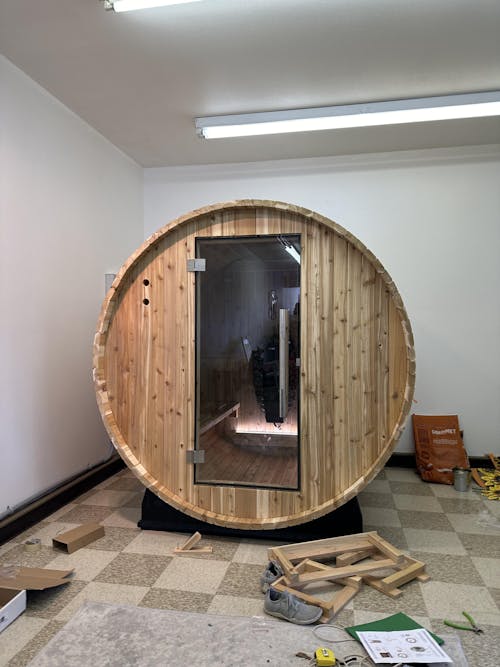
We ordered the 4 person barrel sauna and love it! We wanted a little extra space for the 2 of us/guests and it’s great. We could definitely fit 4 people in it if we needed. We use it every single day. It took about 10 weeks to get here because they build it specifically for the order. Putting the barrel together was fairly easy with 2 people. The electrical and the heater definitely required an electrician to install as we could have not done it alone.
We ordered the biggest heater (harvia spirit 8kw) and it heats up the sauna in about 15 mins inside our 40-50° garage. Overall this style of sauna is hotter and you sweat a lot faster than in an infrared sauna. I truly 10/10 recommend!
Pic is of us in the middle of building it.
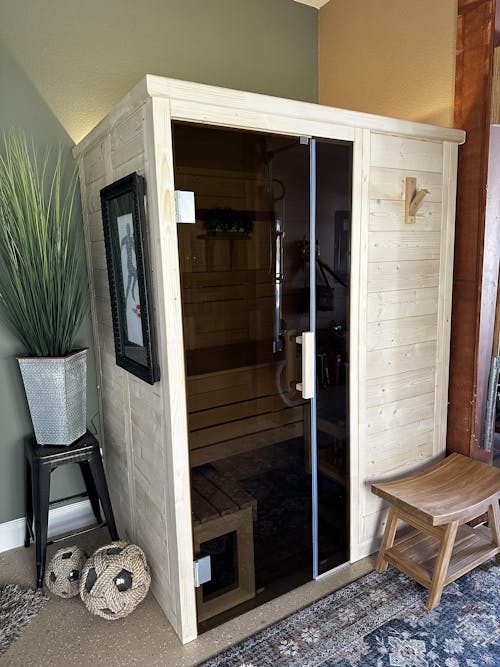
Took me about 6 hours over 2 evenings to assemble almost all by myself. Had a pro run a new circuit from my panel. Very well made and assembly was straightforward. Heater is well sized and reaches operating temperature in under 30 minutes.
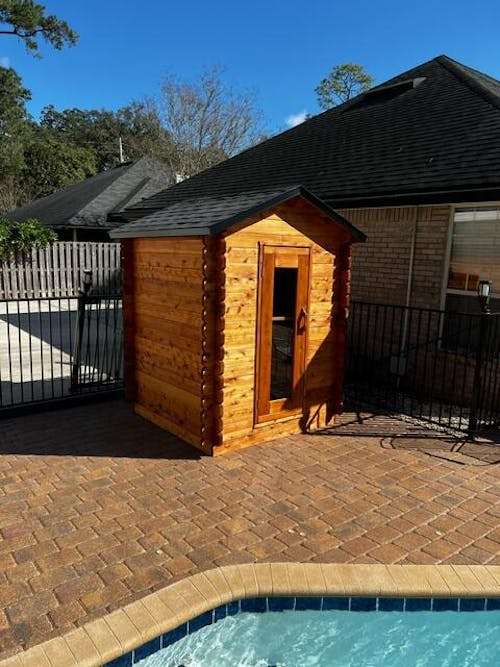
Great sauna very easy to assemble
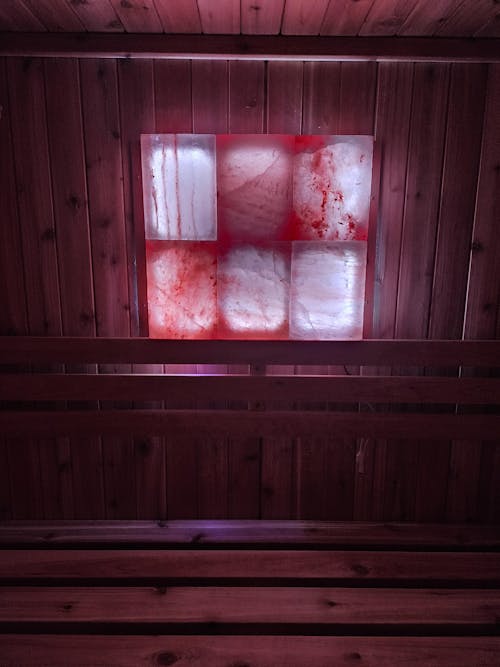
The salt panel was a great addition to our Madison Sauna. It has excellent grain which is accented by the amazing color lights that glow through the panel. Also when you hit the rocks with a splash of water you can feel the heat bounce off the panel. Great addition if you are considering this option.
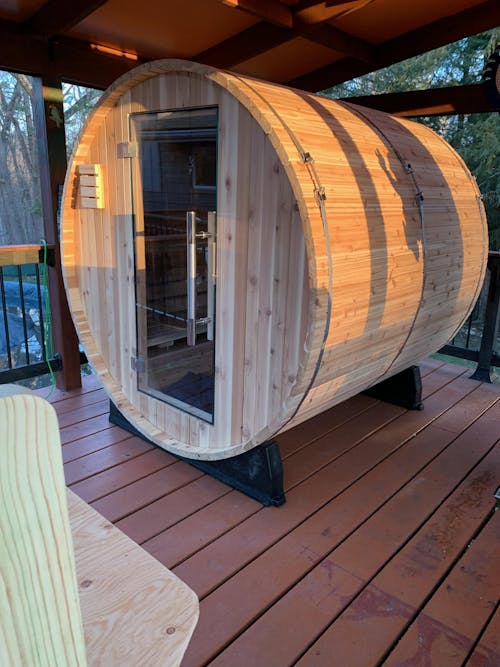
We can say enough about Sauna World there customer support is great! Our Pinnacle Sauna from Almost Heaven is epic.
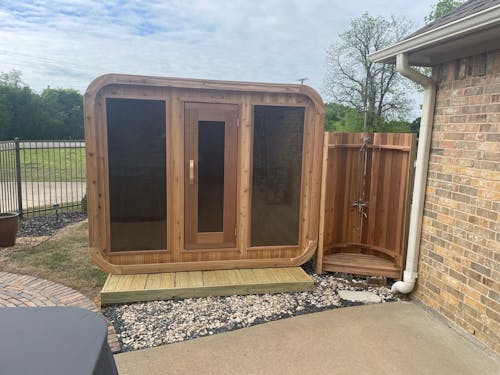
The finish and quality is outstanding and it was quick and easy to assemble.
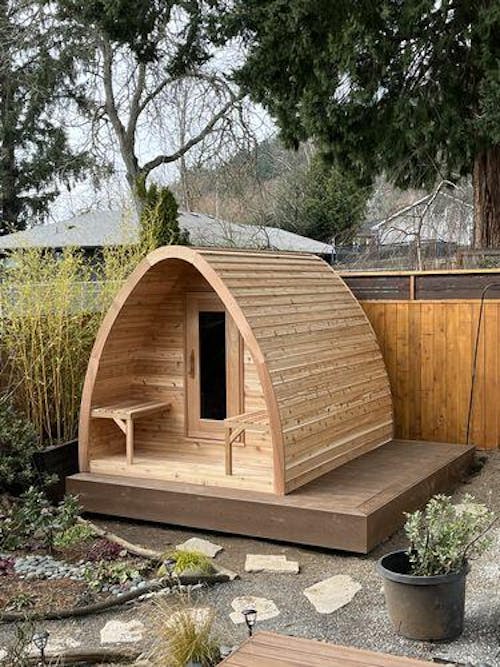
We are thrilled with our mini pod!! It came well shipped and our friend assembled it in 11 hours! Wow! We cannot wait to get healthy and sauna it up!
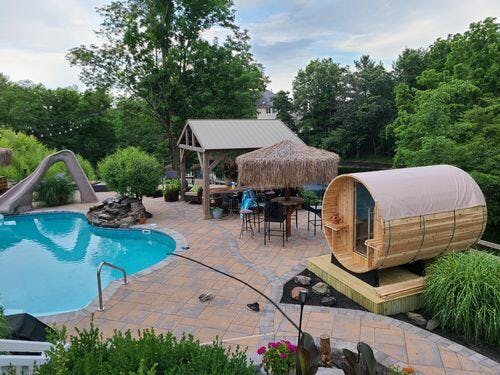
Beautiful sauna!!! Much easier than I expected to assemble, took a total of 4 hours. Can't wait to get warm by the pool on those cool evenings. Customer service was excellent..

Purchased a 2 person Almost Heaven barrel sauna and were delighted with the product. The order process was quick and easy, the sauna arrived on-time, installation was simple, following the provided instructions, and the sauna is extremely high quality. We’ve used it daily for over 2 weeks and quite frankly I don’t know how we lived without it. If I had it to do over again I wouldn’t change a thing... except maybe purchasing a 4 person model to easier share with friends!
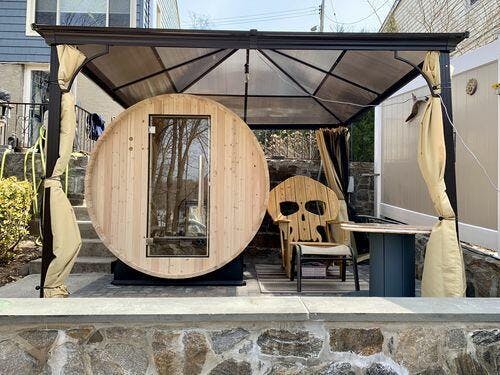
Great Customer Service and a breeze to put together.Excellent shipping and the Sauna is top notch, couldn’t be happier






























